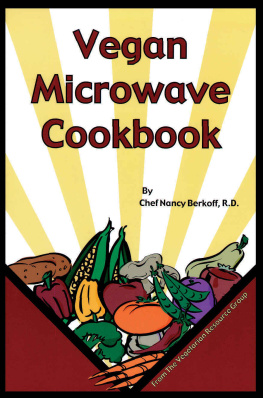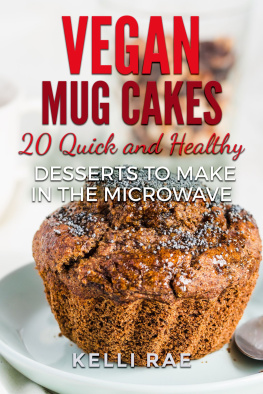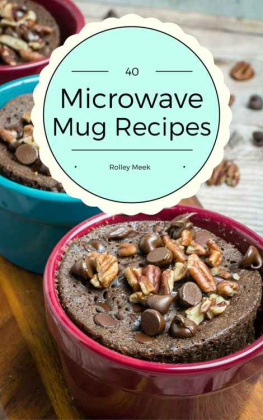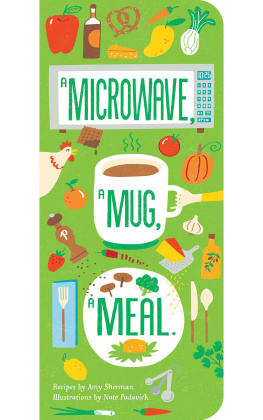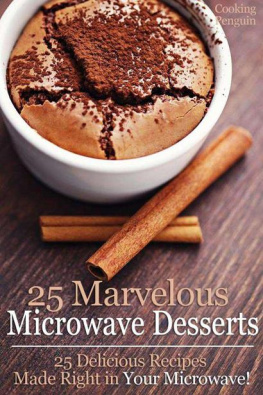Dedication
Vegan Microwave Cookbook is dedicated to Bob, who let me smoke up his microwave, singe his cooking turntable, and devise frightening meal combinations in the name of nutrition. To Bob, who ministered to my computer and insisted on a policy of back up often. For all his general wonderfulness, I promise a lifetime of happiness (and no more quinoa-bean loaves).
Vegan
Microwave
Cookbook
By Chef Nancy Berkoff, RD

The Vegetarian Resource Group
Baltimore, Maryland
A Note to the Reader
The contents of this book and our other publications, including web information, are not intended to provide personal medical advice. Medical advice should be obtained from a qualified health professional. We often depend on product and ingredient information from company statements. It is impossible to be 100% sure about a statement, information can change, people have different views, and mistakes can be made. Please use your own best judgement about whether a product is suitable for you. To be sure, do further research or confirmation on your own.
Copyright 2003, The Vegetarian Resource Group
PO Box 1463, Baltimore, MD 21203.
Cover artwork by Lance Simons
Illustrations by Rowen Leigh
Library of Congress Cataloging-in-Publication Data
Berkoff, Nancy.
Vegan microwave cookbook / by Nancy Berkoff.
p. cm.
Includes index.
ISBN 0-931411-26-2
1. Vegan cookery. 2. Microwave cookery. I. Title.
TX837.B477623 2003
641.5'636--dc21
2003010890
10 9 8 7 6 5 4 3 2 1
All rights reserved. No portion of this book may be reproduced by any means whatsoever except for brief quotations in reviews, without written permission from The Vegetarian Resource Group.
Table of Contents
ACKNOWLEDGMENTS
Thanks to Eben Packwood, David Herring, MS, RD, and Susan Petrie for proofreading the manuscript and making suggestions. A big thanks to Debra Wasserman for editing and laying out the entire book. Thanks to Sarah Ellis, MS, RD, for providing the nutritional analyses for each recipe.
Preface
Fast, easy, good-tasting, exciting, comforting. Words that describe what people want from their meals. Words that decribe microwave cooking.
Just about everyone would like to come home to a pot of soup thats been slowly simmering on the stove all day. Or wake up to hot muffins in the morning. However, unless you have an enchanted kitchen, these dream dishes are probably not going to materialize unless you become acquainted with your microwave. Your microwave holds the secret to any type of meal you desire: comforting, indulgent, holiday, ethnic, nutritious, and fun. You and your microwave can form a great team. You shop and chop, your microwave will steam and stew.
Many of the recipes in this book will take under 10 minutes to cook. The preparation time will vary depending on your kitchen skills and the form in which you purchase your ingredients. For example, pre-shredded carrots cost a bit more than whole carrots, but they save you time. Youll decide, based on your schedule and your budget.
Preparing microwave meals will allow you to have more home-cooked meals. No longer will there be excuses for grabbing a fast food nosh. The extra 15 minutes you took to wait on line at a restaurant is about the amount of time you need to prepare a great meal at home. Microwave cooking is fast and offers instant gratification.
Youll find a variety of recipes in this book. Some are best for busy school or work mornings or night, others are good for entertaining. Many take advantage of seasonal ingredients and some are perfect for eating now and freezing some for later. Whatever your life style and your cooking space, youll find recipes that will fit your microwave cooking desires.
Introduction
If You Can Boil Water, You Can Cook with a Microwave!
Well start with the easy part. Once you know how to boil water in your microwave, you can estimate the heating time for foods, and you can make yourself a fast cup of tea or instant coffee to boot.
A general rule of thumb for microwaves is that about 1 cup (8 ounces) of water should boil in 2-3 minutes on HIGH. So, test it out. Fill a microwaveable cup or glass that holds 8 ounces with cool tap water. Place it in the center of the microwave and set the microwave for 3 minutes on HIGH. Now watch. See how long it takes for the water to come to a boil. Now you know!
If you use a lower power, like MEDIUM, then it will probably take twice as long, about 6 minutes, to boil water. If you use twice as much water, 2 cups, then it should take twice as long or 6 minutes on HIGH. You get the idea; read on.
What? You Say, Cook Nutritious Food in a Microwave? Food Even My Friends Will Enjoy?
Yes, not only is it possible, but its also quick, requires less clean-up than traditional cooking methods, and in some cases, can actually retain more nutrients in the foods you cook.
Learning to cook with a microwave takes a little time, a little effort, and a little concentration. Just as you learned how your traditional oven works, youll evolve with your microwave.
Depending on your menu, you may prepare an entire meal in your microwave or may use it as an integral part of your cooking assemblage to free up an extra burner or part of the oven. If you have limited kitchen space, or no kitchen space, the microwave can be your link to varied cooked meals.
The recipes in this book may contain a little more information than conventional recipes. Because we want to take as much guess work out as possible, weve included more details than simply saying cook on high. Take the time to read through the recipes so youre familiar with the instructions before you start. After a short time, youll know how your microwave cooks various foods and will be able to select the best settings for the most uniform cooking.
Many of the recipes in this book take 15 minutes or less for kitchen preparation and less than 10 minutes to cook. Some actually take only 15 minutes from the start of preparation to the commencement of eating.
You dont have to be vegan to enjoy these recipes. If you simply want to trim calories, youll like microwave cooking. You dont need to grease the pan, since foods dont stick. You can saut in a few drops of water or stock, instead of oil or margarine. You can steam wonderfully without any extra contraptions in your microwave. Its also easy to microwave single portions, so you can cut down on leftovers (or overeating). Some foods are thought to retain more nutrients in the microwave. This could be due to the retention of natural fluids and reduced cooking time.
How Do Microwaves Work?
Microwaves (the waves themselves, not the ovens) are attracted to molecules that are made of water and ingredients that contain water, such as fat and natural sugars. Microwaves induce water-containing ingredients to vibrate at a very fast rate, causing friction. The friction translates into heat. In other words, microwaves get water molecules so excited that they bump into each other at a faster and faster rate until they become very hot. This event is similar to rubbing two sticks together until you create fire.
Microwaves can penetrate approximately 3/4 to 1-1/2 inches into food. Believe it or not, microwaves cook from the outside in, not from the inside out. The heat from the outer edges of food is conducted into the interior. The heat is trapped inside and the heated molecules vibrate their way back out. Those dancing water molecules that have been heating while your microwave oven is on will continue to heat for about 2-3 minutes after the microwave oven is turned off. This is important to note for two reasons:
Next page
